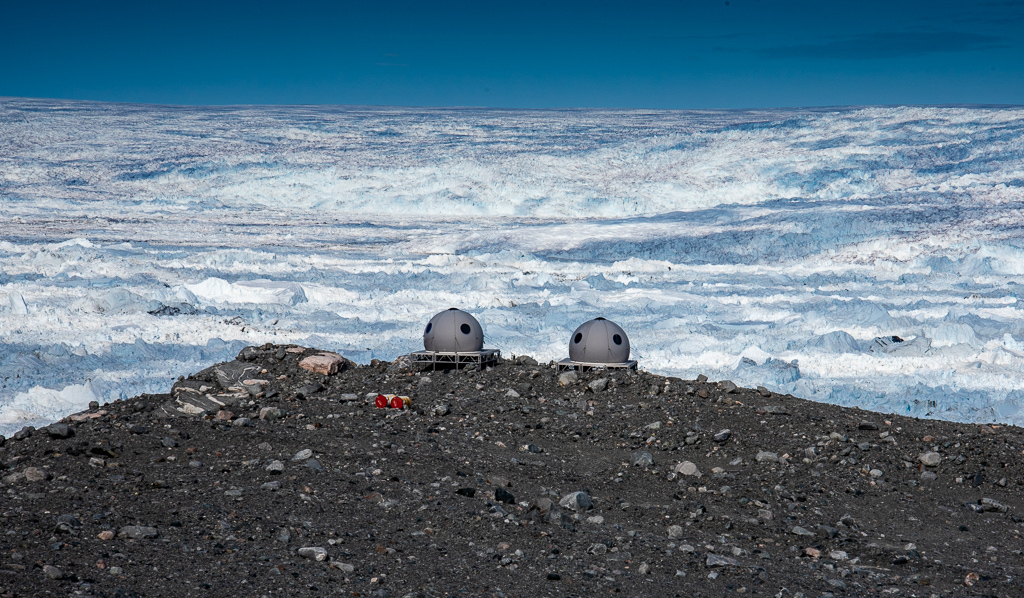From the sky
/The helicopter was red and it stood out against the powder blue sky. It could carry 11 passengers and that meant that our Arctic Guide, Ken Burton, and Renee would join the owners and guests for the scenic flight over the Sermeq Kujalleq ice flow. We had seen it from the land; we had seen it from the water; now it was time to see it from the air. The Bell 212 helicopter hammered the air and lifted off. "It was very loud," Renee told me later. "But luckily we all had headsets." The chopper flew from the airport directly to the ice sheet, about 30 miles inland and landed on a rocky promontory near the ice. "I felt like I was on the moon again," Renee laughed. "It was rock under the helicopter but out towards the edges, I found quartz and -- it was weird -- sand; there was really fine sand; it must have been moondust."
Out on the edge of the rocks, there were two round pods, which Ken identified as rescue pods, in the event that the helicopter became stranded and humans needed to spend a night or two before being rescued. From the rocky ledge, the Greenland ice sheet, stretched out in all its glory, as far as the eye could see. "The facts about this sheet are pretty impressive." I could tell Ken was about to share some of his encyclopaedic knowledge. "It is the second largest ice body in the world, after the Antarctic ice sheet. It's 1,500 miles long in a north-south direction, 680 miles wide east and west. When you're standing on top of the ice sheet you are at an altitude of 7,000 ft. The ice under your feet is generally more than 1.2 miles thick and almost 2 miles at its thickest point. If the entire 684,000 cubic miles of ice were to melt, it would lead to a global sea level rise of 24 feet."
The helicopter took to the skies once again and on this part of the trip, the group followed the ice topography -- from where the sheet spawns the glacier to where the glacier meets the sea. "It's not all the same," Renee said. "The ice sheet is pretty uniform, but as the river of ice gets closer to the sea, it looks different."
"A relatively round, smooth surface dominates the sheet and glacier," elaborated Ken. "During summer, sinkholes on glaciers called moulins form on the sheet; that's where summer meltwater streams on the surface of the glacier finds a crevasse or other weak spot in the ice and begins to pour down through the ice." Apparently, Moulins look like holes in the ice, can be quite symmetrical. Water entering these holes may travel all the way to the glacial base, lubricating the land ice interface.
"But once the glacier meets the sea, things change dramatically," he continued. "The ice meets the seabed and the water; it starts to float. It cracks and breaks. Jagged teeth rise up from the stresses. Ice bergs are born."
They flew out over the sea, right over the spot we had hiked to the day before. Over the bergs and clear water, they found whales, swimming in the bays created by the bergs, their long pectoral fins shining beneath the surface, their liquid breaths erupting in to the air.
"It's hard to decide which was more mind-blowing -- the ice sheet or the whales," Renee told me in the wheelhouse.
Perhaps President Trump, who has recently expressed an interest in purchasing Greenland from Denmark, has been captivated by these extraordinary sights as well.
—Jonathan
Photo by Ken Burton
Photo by Ken Burton
Photo by Ken Burton
Photo by Renee
Photo by Ken Burton
Photo by Ken Burton
Photo by Ken Burton
Photo by Ken Burton









